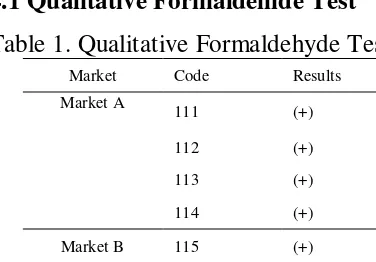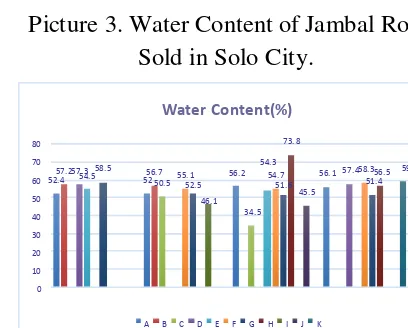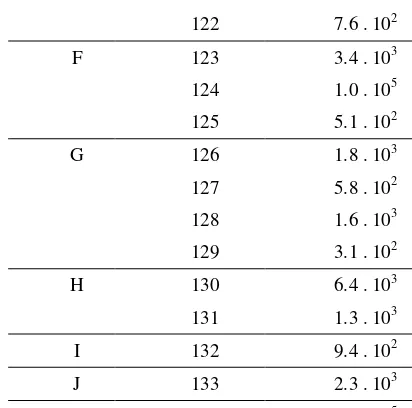The 2nd International Conference on Technology, Education, and Social Science 2018 (The 2 nd ICTESS 2018)
Safety Assement of Jambal Roti Salted Fish in Solo City
Viandra Choirunissa, Merkuria Karyantina, Nanik Suhartatik
Faculty of Technology and Food Industry Slamet Riyadi University, SurakartaJl. Sumpah Pemuda 18 Joglo Kadipiro Surakarta 57136
Corresponding e-mail: viavaaniisaa18@gmail.com
Abstract: Salted fish is one of the common processed fish, such as Ariidae Fish can be processed
into Jambal Roti. Salted fish which made by traditional processing will affect the quality and safety of food. The criteria of safe food was the presence or absence of hazardous components either physical, chemical and microbiological. This study aimed to determine the water content, formalin content, salt content, total plate count,
Escherichia coli, and Salmonella sp from salted fish jambal roti that sold in Solo City. The results of formalin test showed that 21 samples (87.5%) are contained formaldehyde. Salt content in salted fish are range from 4 to 16.9% and it was still lower than the SNI that was set salt content in salted fish by 20%. Water determination results showed 23 samples (95.83%) have higher water content than SNI obligation which was 40%. Total plate count showed that 1 sample was known upper than the SNI maximum standard was 1. 105 CFU/g. Salmonella sp on Salted fish was negative whether E. coli
test report that 25% of the samples were contain Escherichia coli.
Keywords:
E.coli,
formaldehyde, salted fish,
Salmonella
sp, TPC
1
INTRODUCTION
Fish is one food that has a high protein content value of about 15-24% (Syahril et al., 2016). Fish commodities are very susceptible to quality damage, so processing is needed to extend the shelf life. One type of fish processing is salted fish. Ariidae Fish is one if the basic fish (demersal) that can live in fresh water, estuaria, and sea. Ariidae fish has low fat (0.2-2.9 g/100 g) and high protein (12.7-21.2 g/100 g) (Amir, 2014). Jambal roti is one of salted fish processed from Ariidae fish. The term of jambal roti appears because after frying, the texture of jambal roti crumbly like a toast (Burhanuddin et al., 1987). Jambal roti is very popular in Java. The production centers of jambal roti are Pekalongan, Cilacap, Cirebon,
Pangandaran, Rembang, and along the North Coast of Java.
Suprihatin and Romli (2009) stated that salted fish processing in the traditional way relies on drying with sunlight depending on weather conditions. Changes in unpredictable weather conditions resulted in incomplete drying of salted fish. To cover the disfavour,
some processors use harmful chemical
preservatives, such as formaldehyde and bleach (Yuliana et al., 2011). Consumers like jambal roti because of its crunchy texture, but jambal roti still needs to be analyzed by food safety.
58
content in salt fish as much as 40%. Water content affects the quality of food, in terms of preservation usually water content of product will be reduced until it reaches a limit, so
microorganisms can’t grow (Tutianvia, 2006).
Salted fish that has high water content but can last a long time require additional ingredients preservatives. The use of salt as a preservative is particulary dependable in its ability to inhibit bacterial growth and the activity of the decaying enzyms found in the body of salted fish (Afrianto and Liviawati, 1989). The addition of salt in the process of salted fish can
inhibit the growth of Salmonella sp and
Eschericia coli. Some salted fish product that has high water contnet are suspected to contain elements of preservatoves or other chemical
capable of inhibiting the acititvity of
decomposing microbia. The aims of the research was to analyzed water content,
formaldehyde content (qualitatively and
quantitatively), salt content, TPC, Salmonella
sp, and Eschericia coli.
High salt content also affects the safety of salted fish. Indonesian National Standard determines salt content in salted fish not more than 20%. High salt will trigger high blood pressure disease that can lead to heart problems and stroke (Riana, 2015).
High formaldehyde content in the body can cause stomach irritation, allergies, carcinogenic (causing cancer) and mutagenic (causing changes in cell function), as well as people who consume can be vomit, diarrhea mixed with blood, blood mixed urine, and deaths caused the failure of blood circulation (Cahyadi, 2009).
Salmonella sp is a gram negative, rod shaped diameter 1 -3.5 μm x 0.5- 0.8 μm, moves with peritrichous flagellum, is easy to grow in ordinary seedlings and grows well in bile-containing seeds. Salmonella sp grows in aerobic and facultative anaerobic atmosphere at
15 - 41OC with optimum growth temperature of
37.5OC and growth pH 6 - 8 (Murti, 2017).
Widyani and Suciyaty (2008) argue, E. coli
is normally present in the human intestine.
Escherichia coli is a short-gram-negative
(kokobasil) bacterium, measuring 0.4 to 0.7 μm,
anaerobic facultative and has peritrichous flagella, usually not spores (Kaiser et al., 2005).
2 RESEARCH METHOD
This research is an observational research. Samples were taken from 11 markets in Solo City with a total of 24 samples of jambal roti.
2.1 Tools
Scales (Ohaus), measuring cups, oven
(Memmert), muffle (Naberthem),
Spectrophotometer (Thermo Scientific), vortex, petridish, electric stove, test tube, Erlenmeyer, glass beaker, autoclave (All American), incubator (Memmert), tweezers, water bath (Memmert), desiccator (30cm), and clamp.
2.2 Ingredients
Jambal roti, Plate Count Agar (Merck),
Salmonella Shigella Agar (Merck), Violet Red Blue Agar (Merck), NaCl (pa), kalium khromat (pa), and chemicals for analysis used in this research was pro analysis quality.
2.3 Research Method
Jambal roti has investigated for two aspects including, chemical factors and microbiological factors. Microbiological factor research used serial dilution method with pour plate method which include TPC (Plate Count
Agar, Merck), Salmonella sp (Salmonella
Shigella Agar, Merck), and Eschericia coli
(Violet Red Bile Agar, Merck).
28. 19
Formaldehyde Content (ppm)
A B C D E F G H 1992), salt content used Kohman method
(Sudarmadji et al. 1997), and qualitative and quantitative levels of formaldehyde content (Riana, 2015).
Qualitative levels of formaldehyde content, analyzed by the phenilhydrazine method (Riana, 2015). Twenty to thirdly grams of samples fed into distillation flasks and then add with 200 ml of aquades. The filtrate then
Quantitative levels of formaldehyde
content analyzed by the spectrophotometry method (Riana, 2015). Standard solution of formaldehyde made by using 0.027 ml of 37% of formaldehyde and adding 500 ml of aquades or 20 ppm in concentration. Standard curves
which describe the relation between
formaldehyde content and absorbance made by using serial dilution of the standard solution. All of the serial solutions then add with 1 ml of 1% phenyl hydrazine, 5 ml of HCl 50% and 2
ml of 5% K3Fe(CN)6. Absorbance was
measured at wavelength of 520 nm.
4
RESULTS AND DISCUSSION
4.1 Qualitative Formaldehide Test
Table 1. Qualitative Formaldehyde Test.
Market Code Results health number 1168/MenKes/PER/X/1999, who explained that formaldehyde was harmful chemical preservatives. Then samples that has positive results continue with quantitative test for formaldehyde
.
4.2 Quantitative Formaldehyde Test
60 formaldehyde still spread in the market in Solo. Concentration of formaldehide was between 12.64 to 69.98 ppm.
High formaldehyde content in the body will react chemically with almost any substance in the cell suppres cell function and causing poisoning (Antoni, 2010).
4.3 Salt Content
Picture 2. Salt Content of Jambal Roti Sold
in Solo
Salt content of Jambal Roti sold in was between 4-16.9% and still satisfy the SNI stipulating that salt content in salted fish
should’nt be more than 20%. So, consumers
don’t have to worry if consuming excessively.
But if this salt content is linked to formaldehyde test, low salt levels because salt functions as a preservative has been replaced by formaldehyde.
4.4 Moisture Content
Picture 3. Water Content of Jambal Roti
Sold in Solo City.
SNI was established water content in salted fish are 40%. Twenty tree of twenty four samples had high moisture content (95.83%). High moisture content caused by imperfect drying process. Moisture content affects the durability of a foodtuffs. The higher the moisture contents the shorter the lifetime of the food. So, it is necessary to make the moisture content as low as possible to extent the long life the food. With high value of moisture contents, one has to use of presevative. Some producers
Market code Results (CFU/g)
122 7.6 . 102
F 123 3.4 . 103
124 1.0 . 105
125 5.1 . 102
G 126 1.8 . 103
127 5.8 . 102
128 1.6 . 103
129 3.1 . 102
H 130 6.4 . 103
131 1.3 . 103
I 132 9.4 . 102
J 133 2.3 . 103
K 134 1.3 . 105
Table 2 showed 95,8% sample still qualify of SNI 1 x 105. Low yields may be associated with used formaldehide in sample. But when viewed with the discovery of formaldehyde content in the sample, it is possible to low levels of contamination in samples.
4.6
Salmonela
sp
Table 3.
Salmonella
sp
Source Kode Results
A
111 (-)
112 (-)
113 (-)
114 (-)
B 115 (-)
116 (-)
C 117 (-)
118 (-)
D 119 (-)
120 (-)
E 121 (-)
122 (-)
F 123 (-)
124 (-)
125 (-)
G 126 (-)
127 (-)
128 (-)
129 (-)
H 130 (-)
131 (-)
I 132 (-)
J 133 (-)
K 134 (-)
Existence of Salmonella sp in salted fish ruled by SNI was negative. Based on Table 3 have been known 24 sample of jambal roti was negative from Salmonella sp. The result of this research agree with research from Edita et al.
(2015) in Samarinda the explained the result of
salted fish sample was negative from
Salmonella sp.
4.7
E. Coli
Table 4.
E.coli
Source Kode Result
A
111 1. 10-1 112 Negatif 113 Negatif 114 Negatif
B 115 Negatif
116 Negatif
C 117 Negatif
118 Negatif
D 119 Negatif
120 Negatif
E 121 Negatif
122 4,5 . 10-1
F 123 1.0 . 10-1 124 Negatif 125 2.0 . 10-2
G 126 Negatif
127 1.0 . 10-1 128 Negatif 129 Negatif
H 130 Negatif
131 Negatif
62
J 133 Negatif
K 134 0.5 . 10-1
Based on Table 4 have been known 75% sample of jambal roti was negative from E. coli, but 25% sample of jambal roti was positive Solo City was not safe.
6
REFERENCES
Afrianto, E., dan Liviawati, E., 1989.
Pengawetan dan Pengolahan Ikan. Yogyakarta: Kanisius.
Amir, N., 2014. Keamanan Pangan Produk
Jambal Roti Ikan Manyung (Arius
thalassinus Ruppel) yang Terpapar
Sipermetrin. Skripsi. Universitas
Brawijaya. Malang.
Antoni, S., 2010. Analisa Kandungan Formalin Pada Ikan Asin dengan Metoda
Spektrofotometri di Kecamatan
Tampan Pekanbaru. Skripsi.
Universitas Islam Negri Sultan Syarif Kasim Riau. Pekanbaru.
Burhanudin, D. A., Martosewojo, S., dan
Hoetomo, M., 1987. Sumber Daya Ikan
Manyung di Indonesia. LON-LIPI. Jakarta.
Cahyadi, W., 2009. Analisa Aspek Kesehatan
Bahan Tambahan Pangan. Jakarta: Bumi Aksara.
Edita, E., Ahmad, I., dan Rusli, R., 2015. Analisis Cemaran Mikroba pada Ikan
Asin Air Tawar di Samarinda.
Prosiding Seminar Nasional Kefarmasian ke-1. Samarinda.
Febriyanti, D., Pujiati, R. S., dan Khoirun,
2015. Total Plate Count dan
Staphylococcus aureus pada Ikan Asin
Manyung (Arius thallasinus) di TPI
Puger Kabupaten Jember. Skripsi.
Universitas Jember. Jember.
Kaiser, C., Merwe, R. V. D., Bekker, T. F., dan
Labuschagne, N., 2005. In-vitro
ihibition of mycelia growth of several
phtopathogenic fungi, including
phytophthora cinnamon by soluble
silicon. South African Avocado
Growers Associaton Yearbook (28): 70-74.
Murti, M. K., 2017. Kemampuan Ekstrak
Etanol Daun Jeruk Purut (Citrus hystrix
D.) untuk Menghambat Escherichia
coli dan Salmonela sppada Susu Segar. Skripsi. Universitas Slamet Riyadi. Surakarta.
Riana, 2015. Kandungan Formalin dan Kadar Garam pada Ikan Sunu Asin dari Pasar
Tradisional Makassar, Sulawesi
Selatan. Skripsi. Universitas
Hasanuddin. Makassar.
Suprihatin, dan Romli, M., 2009. Pendekatan
Produksi Bersih dalam Industri
Pengolahan Ikan: Studi Kasus Industri
Penepungan Ikan. Jurnal Kelautan
Nasional (2): 131-143.
Syahril, Soekendarsi, E., Hasyim, Z., 2016. Perbandingan Kandungan Zat Gizi Ikan
Mujair Oreochormis mossambica
Danau Universitas Hasanuddin
Makasar dan Ikan Danau Mawang Goa.
Bioma: Jurnal Biologi Makasar (1): 1-7.
Tutianvia, A. K. D., 2006. Penggunaan Bahan
Pemutih Hidrogen Peroksida (H2O2)
pada Ikan Teri Nasi (Stelophorus
commersonii) Kering Tawar. Skripsi. Institut Pertanian Bogor. Bogor.
Widyani, R., dan Suciyaty, T., 2008. Prinsip Pengawetan Pangan. Cirebon: Swagati Press.
Yuliana, E., Suhardi, D. A., dan Susilo, A., 2011. Tingkat Penggunaan Bahan Kimia Berbahaya pada Pengolahan Ikan Asin: Kasus di Muara Angke dan
Cilincing, Jakarta. Jurnal Pengolahan


